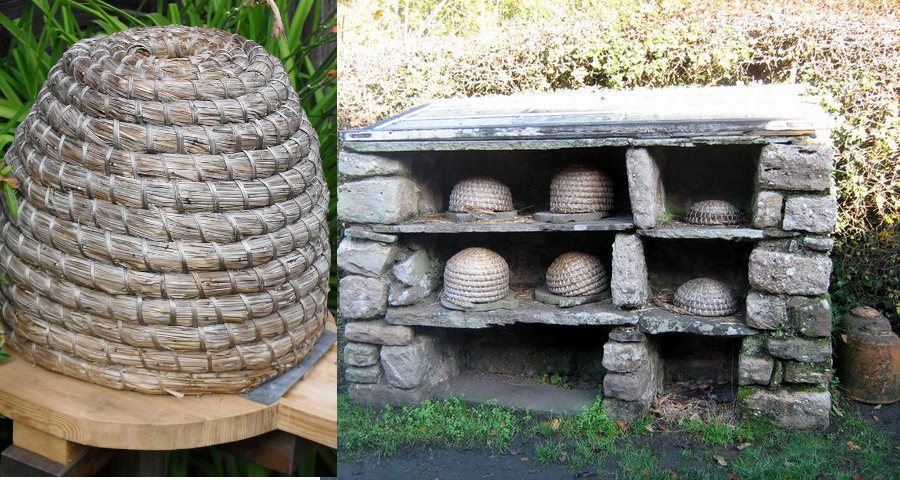Honeybees in Virginia

honeybees (Apis mellifera) arec a non-native, invasive species in Virginia
Source: Free Range, Bees Gathered in a Beehive
The honeybee (Apis mellifera) was introduced from England in 1622. The Virginia Company loaded a ship with species common in England which colonists could farm, part of the attempt by the London Company investors to broaden the economy of the colony beyond tobacco. The ship brought cages of rabbits (connies), which already existed in Virginia in the wild, to provide a new source of domesticated livestock. The investors wrote to the colony:1
- We have by this ship and the Discovery [another ship] sent you divers sorte of seed, and fruit trees, as also Pidgeons, connies, Peacock maistives [mastiffs], and Beehives, as you shall by the Invoice perceive; the preservation and increase whereof we recommend unto you.
The new, introduced honeybees swarmed naturally and spread widely. They were kept by the colonists in traditional "skeps," and harvesting the wax and honey required destroying the hive. Lorenzo Langstroth did not invent the modern beehive until 1851, finally allowing beekeepers to maintain a hive while removing the wax and honey.

Virginia colonists raised honeybees in traditional "skeps;" the modern hive was not invented until 1851
Sources: Wikipedia, Bee Skep and geograph, Bee skeps at St Fagans
In 1622 Native Americans were already familiar with the multitudes of biting insects in North America; introduction of the honeybee was of minor concern to them. There were already multiple bee species in North American, and even species of "stingless bees" that produced honey collected by the Mayans. A Puritan pastor named John Eliot claimed in the mid-1600's that the Native Americans had so unfamiliar with honeybees that there was no Algonquian language name for them, so honeybees were supposedly called "white man's flies."
That claim may have been manufactured, but it has been a long-lasting story. Thomas Jefferson repeated it in his Notes on the State of Virginia:2
- The honey-bee is not a native of our continent. Marcgrave indeed mentions a species of honey-bee in Brasil. But this has no sting, and is therefore different from the one we have, which resembles perfectly that of Europe. The Indians concur with us in the tradition that it was brought from Europe; but when, and by whom, we know not. The bees have generally extended themselves into the country, a little in advance of the white settlers. The Indians therefore call them the white man's fly, and consider their approach as indicating the approach of the settlements of the whites.
A British officer noted during the American Revolution:3
- ...the bee is not natural to America, for the first planters never observed a single one in the immense tract of woods they cleared, and what I think stands forth a most indubitable proof that it is not the Indians, as they have a word in their language for all animals, natives of the country, have no word for a bee, and therefore they call them by the name of the Englishman's Fly.
Links
References
1. "Honey Bees in Early America: White Man's Flies - Fact and Fiction," Revolutionary War Journal, August 8, 2019, https://www.revolutionarywarjournal.com/honey-bees-in-early-america-white-mans-flies-fact-and-fiction/; "First Importation of Honeybees Into North America," Beesource, June 11, 2015, https://www.beesource.com/threads/first-importation-of-honeybees-into-north-america.313539/ (last checked January 5, 2023)
2. "Honey Bees in Early America: White Man's Flies - Fact and Fiction," Revolutionary War Journal, August 8, 2019, https://www.revolutionarywarjournal.com/honey-bees-in-early-america-white-mans-flies-fact-and-fiction/; Thomas Jefferson, "Notes on the State of Virginia," Prichard and Hall (Philadelphia), 1788, p.79, https://docsouth.unc.edu/southlit/jefferson/jefferson.html (last checked June 18, 2024)
3. Thomas Anburey, Travels Through the Interior Parts of America: In a Series of Letters, Volume 2, 1789, p.282, https://www.google.com/books/edition/Travels_Through_the_Interior_Parts_of_Am/ymwFAAAAQAAJ (last checked June 18, 2024)
Virginia Agriculture
Virginia Places


